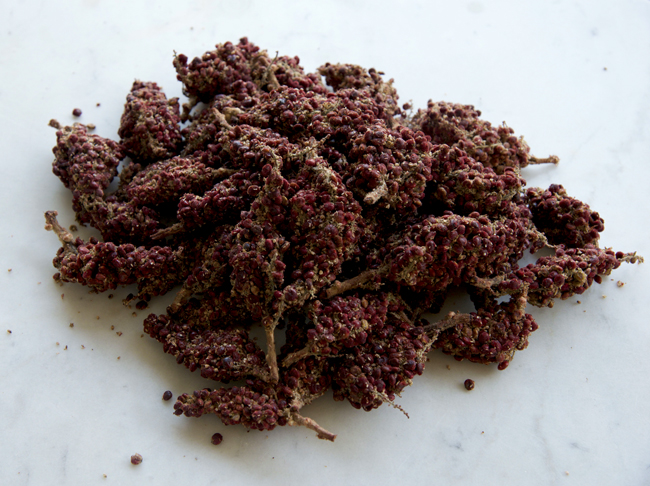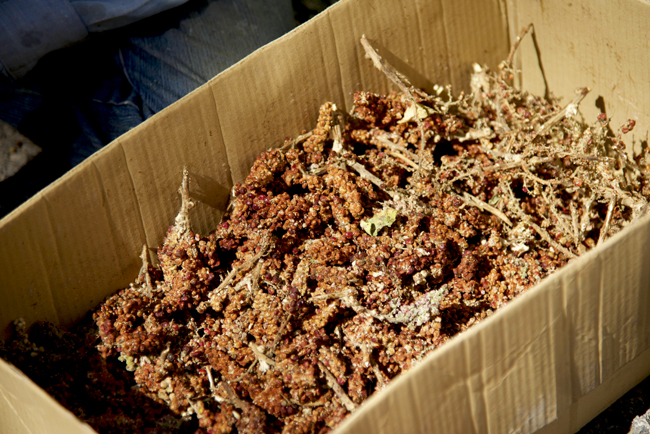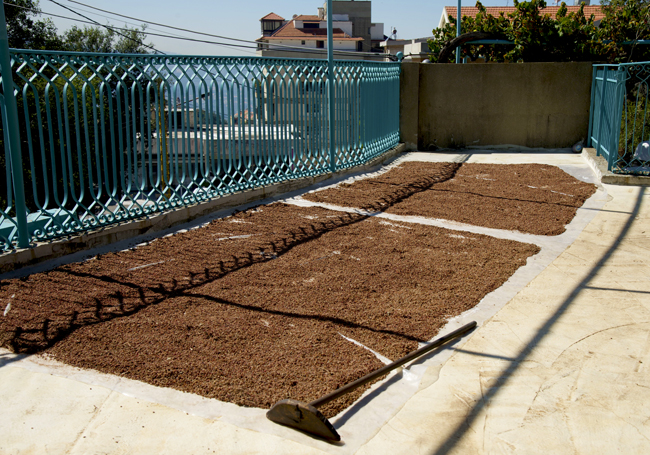11
Oct
 When I wrote my Lebanese cookbook more than 20 years ago, sumac was still a relatively unknown ingredient, unlike now when almost everyone knows what it is, and more to the point can find it fairly easily. Anyhow, my mother told me all about how it is picked and dried, and then ground and I put all the information in the book together with how if you picked it from the wrong plant, you could die. Thank goodness for my mother being the fount of knowledge on all things culinary in Lebanon because I had never seen sumac either on the plant, or being dried and until recently, I only knew it in its ground form. But one day, a few years back, I was walking through souk el-Attarine in Aleppo and I found stalls selling sumac on the branch (‘ala al-‘anqoud as it is described in Arabic) and whole berries after they have been rubbed off the branch; and one guy was selling it ground with the seed and ground without — I honestly could not tell the difference. And two years ago, I found it being sold on the branch driving through the south of Lebanon . However, it is only two days ago, that I finally saw the whole process.
When I wrote my Lebanese cookbook more than 20 years ago, sumac was still a relatively unknown ingredient, unlike now when almost everyone knows what it is, and more to the point can find it fairly easily. Anyhow, my mother told me all about how it is picked and dried, and then ground and I put all the information in the book together with how if you picked it from the wrong plant, you could die. Thank goodness for my mother being the fount of knowledge on all things culinary in Lebanon because I had never seen sumac either on the plant, or being dried and until recently, I only knew it in its ground form. But one day, a few years back, I was walking through souk el-Attarine in Aleppo and I found stalls selling sumac on the branch (‘ala al-‘anqoud as it is described in Arabic) and whole berries after they have been rubbed off the branch; and one guy was selling it ground with the seed and ground without — I honestly could not tell the difference. And two years ago, I found it being sold on the branch driving through the south of Lebanon . However, it is only two days ago, that I finally saw the whole process.

I was trying to find the shortcut from Emile’s bakery to my mother’s house and I got lost — it had been a year since I had visited and what’s more I have no sense of direction! As I took another wrong turn, I came across two lovely Egyptian guys rubbing the sumac berries off the branches. Preparing the year’s stock for their boss outside whose house they were working. Unfortunately the boss was not there for me to ask if I could buy some of his sumac but then both Sabah and Emile the baker came to the rescue. Anyhow, I had a nice chat with them and asked them if they would give me at least a few sprigs so that I could take photographs which they very kindly did. They also picked a fresh branch to show me what sumac looks like before it is dried. Another first for me. Obviously I was not doing my job properly when I wrote my book but it was during the civil war!



And so we come on to Sabah whose husband has fields of wild sumac which he picks, dries and then sells (the top picture is what I bought from them) and Emile the baker who buys the sumac from people who pick it in the mountains and dries it on his terrace as you can see from the picture below. Unfortunately I went up there too late to see the berries drying on the branches but thankfully not too late to see the berries that he had rubbed off the branches and nicely spread (funnily enough on plastic and not white sheets as they did in the old days even though he is very traditional) to dry completely. I bought some ground from him as well and his sumac is excellent.
 And here are the berries which I also bought from Sabah. Hers are redder and I suspect that is because they are not as dry but I am not entirely sure about this!
And here are the berries which I also bought from Sabah. Hers are redder and I suspect that is because they are not as dry but I am not entirely sure about this!
 And finally here is my entry for sumac from my Lebanese cookbook: Sumac is made with the dried berries of the Rhus Coriaria (Tanner’s or elm leafed sumach, not to be confused with other poisonous plants of the same family). The purplish brown berries are harvested at the end of the summer and left on the branch to dry in the sun. Once dry, the berries are ground and sifted, to get rid of the stony seeds, to produce a coarse textured powder ranging in colour from deep maroon to a brighter red. It has a pleasing lemony taste and is used to season salads, stuffings, fried eggs and grilled fish or meat.
And finally here is my entry for sumac from my Lebanese cookbook: Sumac is made with the dried berries of the Rhus Coriaria (Tanner’s or elm leafed sumach, not to be confused with other poisonous plants of the same family). The purplish brown berries are harvested at the end of the summer and left on the branch to dry in the sun. Once dry, the berries are ground and sifted, to get rid of the stony seeds, to produce a coarse textured powder ranging in colour from deep maroon to a brighter red. It has a pleasing lemony taste and is used to season salads, stuffings, fried eggs and grilled fish or meat.
Tagged : ballouneh, lebanese cuisine, sabah the dry cleaner, seasonal produce, sumac, wild foods ![]() 5
5

There is 5 comments on this post
Warning: Undefined array key 36 in /data/40/0/131/109/783598/user/802494/htdocs/anissahelou/wp-content/themes/Anissa/functions.php on line 377
October 16, 2013 at 7:27 pm
Thanks for this post Anissa. I live in New Hampshire (US) where “sumac” is best know as a poison tree similar to “poison ivy”, I was questioning if it was from the same plant, but if I understand correctly from your post this is a different plant or species?
Thank you
Donna
Warning: Undefined array key 36 in /data/40/0/131/109/783598/user/802494/htdocs/anissahelou/wp-content/themes/Anissa/functions.php on line 377
October 16, 2013 at 9:12 pm
i think it is the same genus with some types being poisonous and the one that produces these berries, rhus coriaria, being edible 🙂
Warning: Undefined array key 36 in /data/40/0/131/109/783598/user/802494/htdocs/anissahelou/wp-content/themes/Anissa/functions.php on line 377
November 10, 2013 at 11:23 pm
Donna: Poison sumac (Toxicodendron vernix), is worse than poison ivy or poison oak; if someone inhales the smoke that comes from burning it, they can develop pulmonary edema! Rhus typhina (http://en.wikipedia.org/wiki/Rhus_typhina) aka staghorn sumac, is what we tend to have on the east coast of North America (I’m in New Brunswick up in Canada), and it was used by the First Nations people to make something akin to lemonade…one would think that if it’s lemony, it could be used in the same way as regular sumac!
There’s also a “smooth” sumac, rhus glabra, which you guys would have down there that we don’t have up here, which would have been used similarly.
Warning: Undefined array key 36 in /data/40/0/131/109/783598/user/802494/htdocs/anissahelou/wp-content/themes/Anissa/functions.php on line 377
November 11, 2013 at 2:29 am
thanks for this stamatia 🙂
Warning: Undefined array key 36 in /data/40/0/131/109/783598/user/802494/htdocs/anissahelou/wp-content/themes/Anissa/functions.php on line 377
October 13, 2014 at 11:36 am
Great Blog I came across it while doing some research on Sumac as a spice. I make a ground product using a sumac found going wild here in the southwest. Three leaf sumac, rhus trilobata has long been used by tribes in four corners area for food, medicine and basket making material. I have heard of the spice sumac but have yet to find how my counter parts in the middle east prepare it or if they are growing it as a crop as we are doing here. Thank you for posting the pictures of your lucky find!